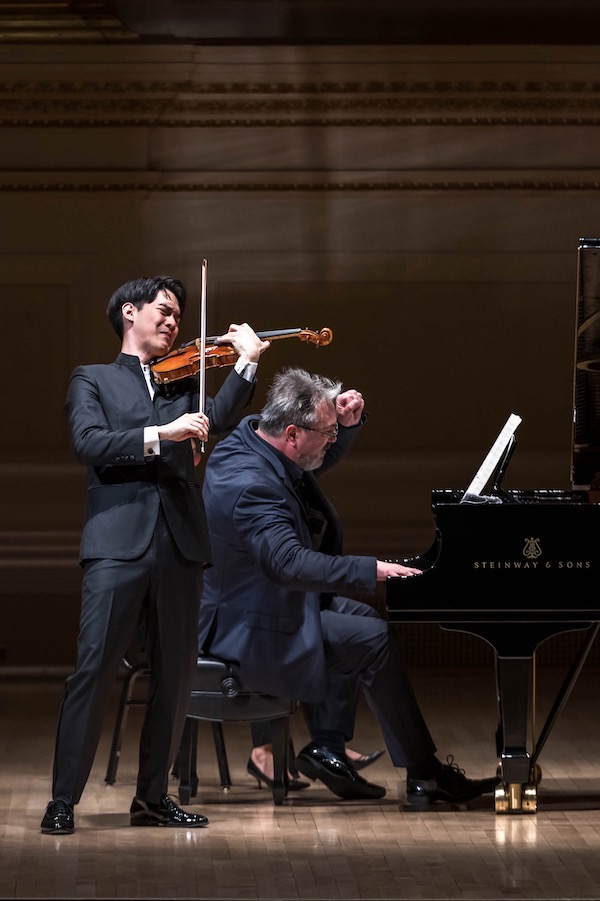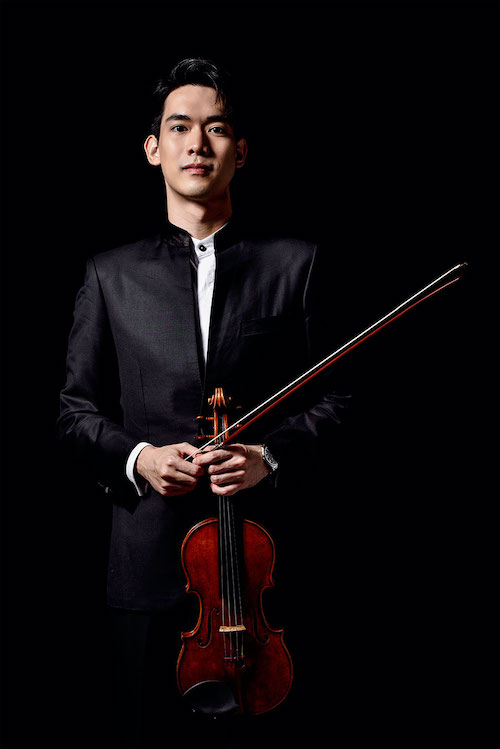Violinist Richard Lin makes a captivating Carnegie Hall debut

If there is a melody that violinist Richard Lin can’t make sing, it wasn’t to be found in his Carnegie Hall debut Friday nght.
Lin’s New York recital was part of the prize package that he received as the Gold Medalist of the Tenth Quadrennial International Violin Competition of Indianapolis in 2018. The competition was established in 1982 under the artistic guidance of Josef Gingold (1909-1995), a Russian-born emigre to the United States, who was the Cleveland Orchestra’s concertmaster under conductor George Szell and taught at the Indiana University Jacobs School of Music for more than thirty years. An impressive number of today’s top violinists passed through his studio.
Born in Phoenix and raised in Taiwan, Lin began his violin studies at the age of four and made his debut at 11 performing the Saint-Saëns Violin Concerto No. 3 with the Taipei Symphony Orchestra. After attending the Curtis Institute of Music and The Juilliard School, Lin has performed with orchestras around the world and has placed in a number of the world’s top violin competitions. As part of his Indianapolis prize, Lin has the use of the 1683 “ex-Gingold” Stradivarius and 2017 Sam Zygmuntowicz for four years. He performed on the latter for this concert.
Lin’s program stuck to the four corners of the classic violin repertoire, but he chose works that were exceptionally rich in lyricism and color. He also has a sense of history, for many of the pieces were associated with the great violinists of the past, to which he is a promising heir with his dashing good looks, charisma and virtuosic skills. And as with many of those past greats, Lin employs his talents in expressing emotion through line and melody, which made this recital so captivating and rewarding.
Lin opened the concert with Vitali’s Chaconne in G minor. Although attributed to the Italian Baroque composer, Tomaso Antonio Vitali, there is debate as to whether he actually composed it due to the work’s adventurous modulations into distant keys that are atypical of the period. The Chaconne has been arranged by various composers and maintained its place in the repertoire as a virtuosic, Romantic-style showpiece. Jascha Heifetz began his American debut recital at Carnegie Hall in 1917 with the Chaconne and regularly performed it as part of his concert repertoire for the next four decades.
Whatever its origins, the Chaconne has a timeless quality, which was heightened by Lin’s exquisite playing of its sweet melody. It was the first of many times throughout the recital, where one sat in a trancelike state mesmerized by the beauty of the sound that Lin coaxed out of his violin.
Richard Strauss is generally associated with his songs, tone poems and operas, but he also composed chamber music, including the Violin Sonata in E-flat Major. Completed in 1888, the sonata was one of Strauss’ first forays into the mix of Wagnerian and Brahmsian styles that became his hallmark. At exactly the same time, Strauss met and fell in love with the soprano Pauline de Ahna, whom he would later marry.
As with many of Strauss’ songs from the period, the sonata contains expressions of his love for her that he conveyed in a lyrical bouquet. For all of the passionate outbursts in the opening and closing movements with their soaring melodies, it was the tender sighs of the second, entitled “Improvisation: Andante cantabile,” that were so memorable, as was the wit, humor and panache which Lin displayed in the finale.
John Corigliano’s career got a jump start when his Sonata for Violin and Piano was the only winner of the chamber-music competition at the 1963 Spoleto Festival in Italy. As his father, John Paul Corigliano, Sr., was concertmaster of the New York Philharmonic for 23 years, it is fitting that violin music has been so important in his son’s career as a composer. Corigliano’s score for François Girard’s 1997 film The Red Violin won an Academy Award for Best Original Score and later became the inspiration for his 2003 Concerto for Violin and Orchestra (“The Red Violin”) for Joshua Bell, who was also the soloist in the movie.
The Corigliano sonata found Lin at his most muscular, as he responded to its energy and technical demands. He could make the pizzicato pop, but again it was his playing of the melodies in the Andantino that were so stunning. This was music that brought out Lin’s lighter side, as he smiled throughout the work, as he reveled in its musical charms.
Igor Frolov was one of the leading Soviet violinists of the late-twentieth century. Although he never formally trained as a composer, he began writing music at the age of 52. Most of his works are neo-romantic fantasies that showcase the beauty and variety of timbres of the violin, but some, such as the Concert Fantasy on Themes from Gershwin’s Porgy and Bess display his love of jazz, which was banned at the Moscow Conservatory when he was a student there. As jazz recordings were also all but impossible to obtain in the Soviet Union, Frolov mostly encountered the genre during on his foreign tours and through film scores.
Listening to Lin play this Concert Fantasy was a combination of ear candy and amazement at Frolov’s ingenuity in setting some of the best-known tunes from Gershwin’s great American opera. The work opens and begins with “Bess, You is My Woman Now,” but in between come, “My Man’s Gone Now,” “I Got Plenty O’ Nuttin,” and “Summertime”. It’s a violin tour de force, which ended the concert with drama and excitement.
For his musical collaborator, Lin chose pianist Thomas Hoppe, who is singularly steeped in violin music, style and history, having served as studio pianist to the legendary Dorothy DeLay at Juilliard and later for Itzhak Perlman. Hoppe was a true partner to Lin, providing not only support, but also infusing the music with his own style and emotion in the music that they so perfectly performed together.
For encores, Lin performed Heifetz’s arrangement of Claude Debussy’s song, “Beau Soir.” It was again an opportunity to luxuriate in the beauty of Lin’s tone and ability to express emotion through his playing. Regarded as one of the greatest violinists of all time, Fritz Kreisler’s Tambourin Chinois was many of the short works for violin and piano to play in his recitals. Apart from Kreisler’s use of the pentatonic scale and some parallel fifths, there is little authentically Asian about it, but it was a crowd pleaser for him and remains so today.
After his final goodbye to the audience, Lin bowed down and kissed the stage of Carnegie Hall, on which the world’s greatest musicians have performed since it opened in 1891, including Kreisler and Heifetz. At the age of 30, it is too soon to tell whether Lin will reach such musical heights as they did, but this gifted young violinist played an exceptionally beautiful recital that offered balm to many on a June evening.



